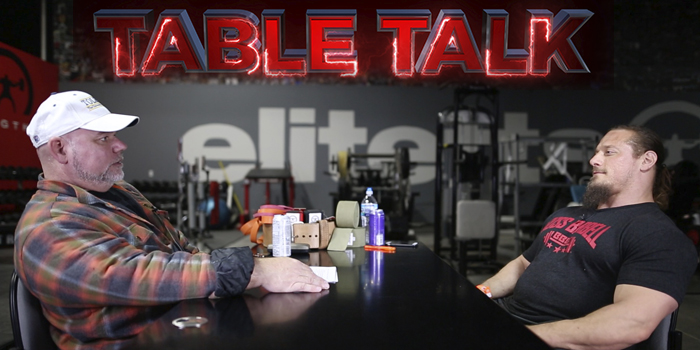
There are two typical perspectives on deloading: you either plan deloads in your training cycle, or you wait and take one only when you feel like your body needs it. For today's Table Talk, Dave has Dan share his thoughts on deloading and how he personally approaches it in his own training.
To begin, Dan talks about what he does directly after a meet. Sometimes after a meet you feel awful and don't even want to go to the gym, but other times you don't feel that bad. Dan's rule is to approach the week after a meet the same way no matter how you feel: you're probably not okay, even if you think you are. Take it easy and don't do anything to hurt yourself. He shares that he has had many scenarios where he has learned this the hard way. For instance, at one meet (in which he squatted 848), when Dan unracked the bar, it was an inch toward his right side and put a lot of pressure on his ribs. He let it settle and got the lift with no problem, avoiding injury altogether. But a few days later he was at a seminar and went to demonstrate a squat using only 135 pounds. As he squatted, one of his ribs popped out of place. It had been barely hanging on since the meet and it took very little to push it the rest of the way. So Dan's rule after a meet is to prioritize not doing anything to hurt yourself.
WATCH: Table Talk with Dan Green — The SS Yoke Bar for Squats and Good Mornings
As a general method of deloading, Dan says he thinks of his training in several segments. If he trains for a meet, he will spend some time wearing knee sleeves and no belt, some time with the belt on, and some time wearing both the belt and knee wraps. The final five to six weeks before the meet he's in his knee wraps and the weights are very heavy. Then after the meet he takes the belt and wraps off and trains in only his sleeves with no belt. At that time the weights are significantly lighter and the reps are higher. Going from training with 800 pounds on a weekly basis to 600 pounds on a weekly basis is a significant difference and very effectively deloads his back. The general idea is to transition in levels of support from pre-meet, meet, and post-meet training. By changing the use of knee sleeves, knee wraps, and the belt, Dan goes from the least amount of support, to a medium amount of support, to the most amount of support. Then it restarts after the meet.
Dave responds to this by following up with another question about using a planned deload within a meet training cycle: if Dan is doing a 16-week meet training cycle, does he have a built-in deload planned at a certain time or does he wait until he feels worn down to back off for a week?
To explain how he approaches programmed deloads, Dan shares his method of exercise selection. He has a variety of exercises that he does during his training cycles, ranging from the main lifts for skill and specificity to the secondary lifts for building leverages and strengths and weaknesses. This includes a lot of variations of the main movement. Some of these variations are overload movements (like the sumo block pull) and some are underload movements (like the deficit deadlift). The intensity is the same for these exercises but the weight is very different. Because Dan knows which exercises beat him up the most and take the biggest toll, and which ones are easier to recover from, he can balance them out in his training. Planning the training stimulus this way helps him avoid having to plan for a deload. It doesn't always work out this way and he will sometimes have to take an unplanned deload, but he typically tries to avoid doing so.
Dave responds that he has a similar philosophy of trying to control recovery over a training cycle by manipulation of exercise selection. For instance, using specialty bars is a great way to accomplish this, because your max on one bar is not going to be the same as your max on another bar, so altering bar selection can enable you to change the workload and weight without changing intensity. When you're beat up, you can pick the things that are easier to recover from so that you're still able to train hard while giving your body what it needs to recover. This is just one of the many benefits a lifter can gain from paying close attention to their programming and learning themselves. By managing fatigue in a style that works for you, you can avoid planned deloads and spend more time training to make progress.









